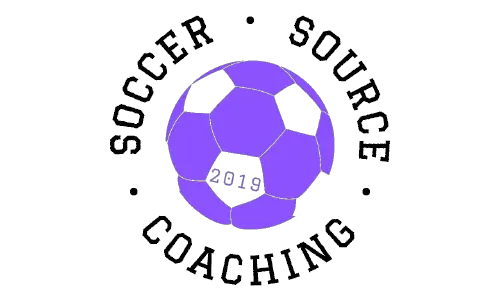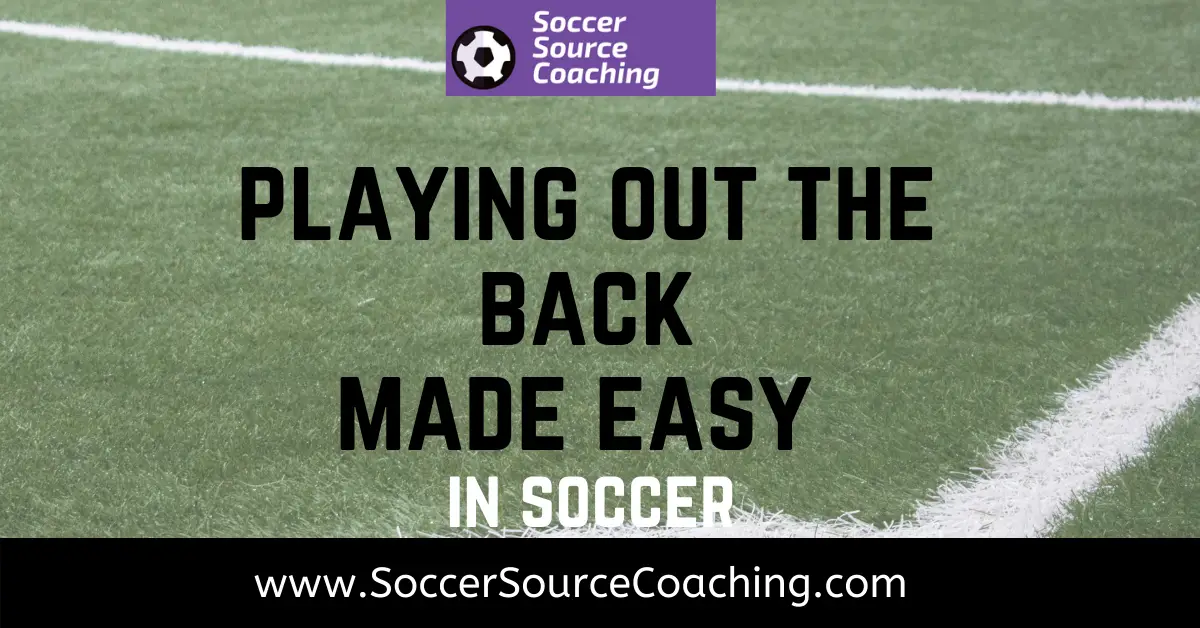In this post, I will give you my best soccer drills for playing out from the back. I will give you the coaching tips that I use to help my teams successfully play out from the back. There will also video of how the drill works and questions you can ask the players to get them thinking independently.
Playing out the back can help create space when playing against defensive teams, as it will encourage them to press high up the pitch.
Playing out the back soccer drills
These easy soccer drills will get your team playing out from the back in no time.
When your defenders win back the ball it will help your team be more composed when in possession of the ball and forms the perfect foundation to build an attack.
4 goal game playing out from the back
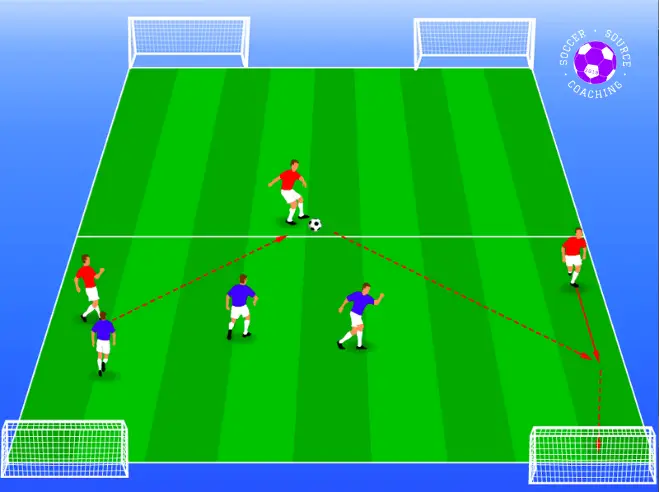
Purpose of the drill:
The purpose of the drill is to help players identify where space is and how to position themselves to support players on the ball if they cannot go forward to try to switch the ball to the player who is in space.
Set up:
- Create a 15 x 20-yard area
- Set up 4 goals in the corners
- Divide your players into 2 teams of 4 or 3 depending on your numbers
Instructions:
This will be a regular scrimmage however teams will be defending and scoring in 2 goals if the ball goes out behind the goal lines I ask the players to take a kick in the middle between the 2 goals.
As there are 2 goals the attacking teams must change the point of attack depending on where the defending team has positioned themselves and where space is
Ask a player to be captain and put players in positions. If it’s a 3v3 ask them to have a central defender, a left midfield, and a right midfield. If it’s a 4v4 introduce a striker.
The role of the central defender is to play a pivot role to provide an option for the player who cannot go forward and switch the ball to the player where the space to attack is.
Coaching points:
- The first thought should be forward, dribble and attack the space if you have space in front of you (Left/Right Midfielder)
- If the player cannot go forward create an option for them to go backward (Central defender)
- Once the Central defender has received the ball their first touch must take them towards space.
- The LM or RM should move to an area where there is space. ( If the left midfielder cannot move forward encourage players to identify that space is on the right side and so as the central defender receives the ball the right midfielder should know to spread as far right as possible)
Questions that can lead to coaching points:
- If you cannot dribble forward where can you go?
- Where can you move to help support your teammate if they cannot go forward?
- If you received the ball, should your first touch be towards the pressure or away from the pressure?
- Where you should go to try and receive the ball?
Why this soccer drill helps teams to play out from the back
This drill gets players comfortable with passing the ball backward and not panicking if they cannot go forward.
It will also help players familiarize themselves with the positions they can take up to support the player on the ball and identify where space is on the field to start an attack.
With this soccer drill for playing out the back, it is incredibly important that their first thought should be to go forward and attack the space/defender and only pass back if they feel they cannot.
Small sided game for playing out the back
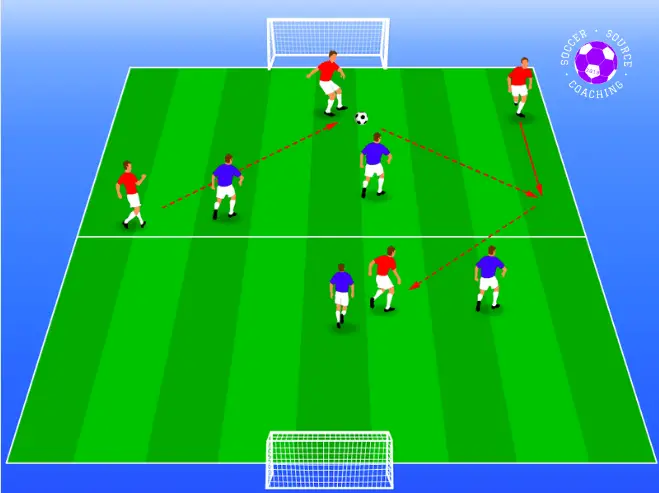
Purpose of the drill:
The purpose of this drill is to limit the number of attackers that can move into the defending team’s half to pressure the defending team.
This will allow the defending to team have more success trying to play out from the back.
Set up:
- Create a 15 x 20-yard area
- Set up 2 goals opposite each other
- Spilled the area down the middle vertically.
- Divide your players into 2 teams of 4 or 3 depending on your numbers
Instructions:
This will be a regular scrimmage however when the team in possession of the ball is in their half only 2 attackers can press the ball.
If the defending team can successfully work the ball from their half to their opponents’ half and score a goal the goal will be worth 3 goals instead of 1.
This will encourage players to support their teammate on the ball whether it be backward or side to side but it also encourages players to find space in more advanced positions to score goals
Ask a player to be captain and put players in positions.
If it’s a 3v3 ask them to have a central defender, a left midfield, and a right midfield.
If it’s a 4v4 introduce a striker.
Coaching points:
- The first thought should be forward, play the ball to the most advanced player on your team.
- If the ball cannot be played forward move the ball sideways or backward to a player who has space to attack going forward
- Find space within your positions to help support the player on the ball either going forwards, backward, or sideways
Questions that can lead to coaching points:
- When we get the ball what should our first thought be?
- If we can’t go forward, what should you be looking to do?
- How can you help support the player on the ball, going forward or playing back?
Why this soccer drill helps teams to play out from the back:
This drill will help players feel more comfortable on the ball with match realistic pressure. By giving your players a 3-goal incentive to play out from their half and attack their opponent’s half you are encouraging them to pass with the purpose to go forward.
Similar to the previous drill in the form of a small-sided game by giving players positions you are helping them understand their roles better and by rotating their positions around you are giving them a better understanding of how the individual roles of the positions can help players see the bigger picture.
Movement tagging game to help your team play out from the back
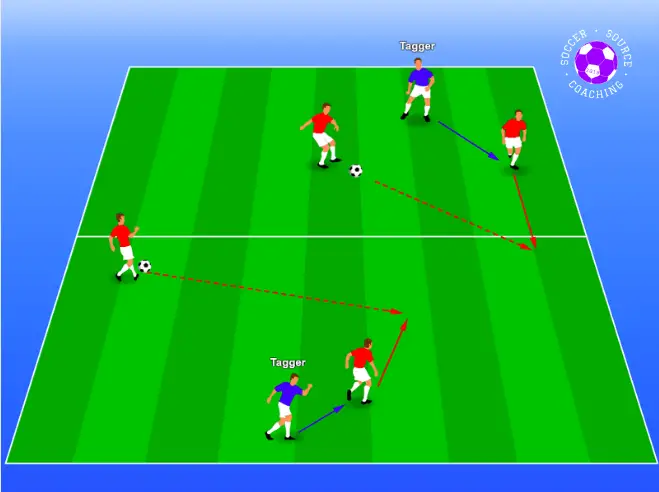
Purpose of the drill:
Often when coaches encourage their teams to play out from the back they organize them in their positions to receive the ball by dropping in wide positions however players are stuck when they are being marked.
So this fun tagging game can be used to help players create their own space so they can receive the ball when they are being marked.
Set up:
- 6 players per area
- 2 soccer balls
- 2 taggers (holds 2 pinnies)
- 15 x 15-yard area
Instructions:
The rules of this game are fairly simple. Players cannot be tagged if they have the ball, they can only be tagged if they do not have the ball.
This means that players who do not have the ball must create space for themselves to receive a pass so they do not get tagged.
If a player gets tagged they swap with the tagger and must try and tag someone else, also if the player with the ball misplaces a pass and it goes outside the area then they will swap with a tagger and have to hold onto the bib.
Coaching points:
- The first movement should be away from the space you want to receive the ball to pull the defender away. Then the second movement should be towards the space you want to receive the ball.
- Communicate with players when you are in an open space to receive the ball
- The pass should be played in front of the player receiving the ball so they can run onto it
Questions that can lead to coaching points:
- What can we do to create space for ourselves?
- How does the player on the ball know when/where to pass the ball?
- Where should the ball be played to the player looking to receive the ball?
Why this soccer drill helps teams to play out from the back:
This fun soccer drill game will help players improve their movement off the ball to help create space for themselves and identify spaces to receive the ball.
Similarly, with the player on the ball, they will be able to read the movements and the runs of these players and develop a better understanding of how, where, and when they should pass the ball.
2v2 square for playing out from the back
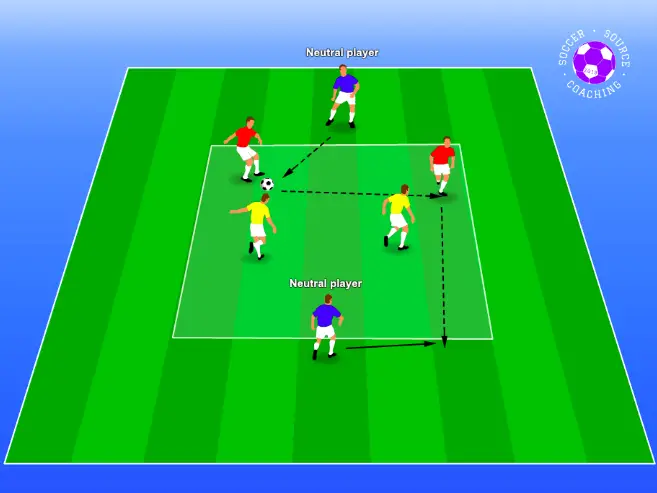
Purpose of the drill:
The purpose of this drill is to get a lot of repetition of creating space for yourself to receive the ball in a tight area or to create space for the player on the outside to directly play the ball to the player opposite them.
Set up:
- 8 x 8-yard area
- 1 ball
- 6 players (4 in the middle 2 on the outside)
Instructions:
The 2 players on the outside will be neutral players and act as target players for the team in possession of the ball.
Every time the ball is worked from one target player to another that team gets 1 point.
If the target player on the outside can make a pass to the opposite target player that splits the defenders it is 1 point for the team in the middle that has possession of the ball.
If the defending team wins the ball they will become the players trying to work the ball to the target player on the outside.
Coaching Points:
- Create space for yourself to receive the ball from the target player on the outside
- Try and remain in the defenders’ blind spots when making your movements to receive the ball
- If you are the target player on the outside without the ball adjust your position so you are always looking to receive the ball between the defenders
Questions that can lead to coaching points:
- How can you create space for yourself to receive the ball?
- Where should we begin to make our movements, where the defender can see us or not see us?
- If you are the target player waiting to receive the ball should you be standing still, what movements could you make?
Why this soccer drill helps teams to play out from the back:
This drill enables a lot of repetition of players constantly moving to create space for themselves by dropping off in wide areas or looking to get in behind.
This drill also emphasizes the importance of playing forward and rewards the target men for being able to pass and receive the ball by splitting defenders.
These players could be a central defender passing to a central midfielder or a central midfielder passing the ball through to the striker.
Passing the ball and keeping possession is great but you always want to reinforce that playing out from the back is a building block to set up attacks.
Rondo variations for playing out from the back
Rondo’s in soccer are a fantastic way to make sure your players are getting a lot of repetition of passing, receiving, and moving off and on the ball. It is also a great way to build players’ confidence and decision-making on the ball.
It’s no surprised that they made up a larger percentage of Pep Guardiola’s training sessions.
Rondo variation 1
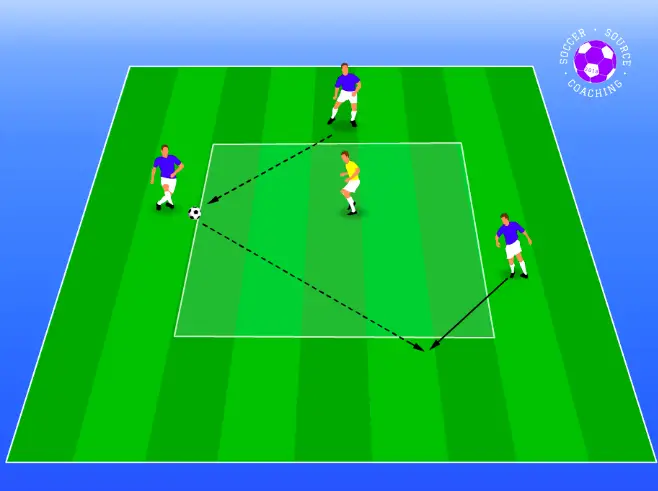
Purpose of the drill:
The purpose of this drill is to encourage players off the ball to move to help support the player on the ball.
Set up:
- 6 x 6-yard area
- 1 ball
- 4 players (1 defender)
Instructions:
Set up your square with 3 players on the outside and 1 defender in the middle.
The players on the outside must keep the ball away from the defender in the middle and see how many passes in a row they can manage.
The only rule is that there can only be 1 player on each side of the square, so there will always be one side free.
Depending on which player receives the ball the players on the outside must communicate and move to the free square to support the player on the ball.
Coaching points:
- Create an angle to help support the player on the ball
- As soon as you have made a pass you should think about how you can help support the player on the ball
- Receive the ball in an open body position with your first touch taking you away from the pressure
Questions that can lead to coaching points:
- Where can you move to help to support the player on the ball?
- What should you be thinking/doing as soon as you have made a pass?
- If you are receiving the ball what should your body position and first touch look like?
Why this soccer drill helps teams to play out from the back:
The main focus of this soccer drill is to encourage players off the ball to help support the player on the ball.
A lot of times players are getting into great positions to receive the ball however players are not reacting to help support them.
This will help players to think 1 or 2 passes ahead instead of reacting to what they are seeing in front of them
Rondo variation 2

Purpose of this drill:
The purpose of this drill is to try and encourage the ball to be played forward, trying to work the ball to create space so that passes can be played through pressing lines.
Set up:
- 8 x 8-yard area
- 6 players (2 defenders)
- 1 ball
Instructions:
Set up your square with a player on each side and 2 defenders in the middle. Players must stay on their side of the square trying to work together to play a pass that splits the 2 defenders.
Every time the 4 players on the outside splits the defenders they get 1 point.
Coaching points:
- Move the ball around to draw defenders in to create the opportunity for a pass to split them
- If you are looking to receive the ball find a position where you can receive the ball between the 2 defenders
- Be patient with the build-up for the opportunity to split the defenders, don’t force it through.
Questions that can lead to coaching points:
- What can we do to create space for the pass to split the defenders?
- If you are opposite the player on the ball how should you be thinking to receive the ball?
- Do we need to rush or can we take our time?
Why this soccer drill helps teams to play out from the back:
The end goal of playing out from the back is to set up attacks, to do this the ball must be worked forward.
Yes, the defenders have a drop into wide positions but equally midfielders and forwards have to try and find gaps between the opposition’s lines to receive the ball.
This rondo variation encourages players to look after the ball and create an opening to place the pass forward.
The benefits of playing out the back
Playing out from the back has numerous benefits.
It allows players to get a better understanding of their positioning, it can help them understand where they can move to find space in their position to receive the ball as well as help them identify space to attack.
This is all on top of developing their technical skills too such as their first touch and body position when passing and receiving the ball.
To get the maximum amount of touches and repetition in game realistic scenarios I would recommend playing small side games for these drills (max 4v4), regardless of age group.
To help players better understand their roles and responsibilities in these small-sided games choose one player to be captain and ask them to organize their team into positions. When you have a break select a new captain to put players in different positions.
Instead of speaking about playing out from the back, I ask players to focus on working together to move the ball to a teammate who is in space and attacking the space.
The basics of building play out from the back
The ultimate goal of building out from the back is to draw the opposing team into your half and exploit spaces in their press to attack when they try and win the ball back.
Trying to get the ball to their attacking players.
Building out from the back can look different from team to team depending on what formation is being played and the tactics deployed by both teams.
But typically central defenders will drop into wide areas to receive the ball with full-backs or wide players moving further up the field in a more advanced wide area.
This creates space in the middle for the central midfielders to check into the space to receive the ball in the middle.
When the central players receive the ball with space to turn where they will look to try and play the ball to players in more advanced positions further up the pitch or drive with the ball into space in front of them.
Playing out from the back-conclusion
There is no quick fix to immediately get your team playing out the back from the back. Remember that consistency is key with your coaching points and session plans!
These essential tactics will help you beat a pressing team!
The drills will help your team be prepared for any of the 4 different types of presses an opposition team may use.
These give-and-go drills are great at helping your players combine passes easily around opposition players, as well as encouraging movement off the ball.
Let me know in the comment section if you have used any soccer drills that have helped your teams play out from the back.
If you know someone who would find this helpful please share the post using our social media buttons.
Thank you,
Toby
Related Posts:
- 15 Soccer Drills For Passing And Moving
- My 10 Favorite Soccer Rondo Drills
- 10 Drills To Stop Your Soccer Team Bunching
- 20 Soccer Drills for 10 year olds
- 20 Soccer drills for 12 year olds
The Youth Soccer Coaching Handbook
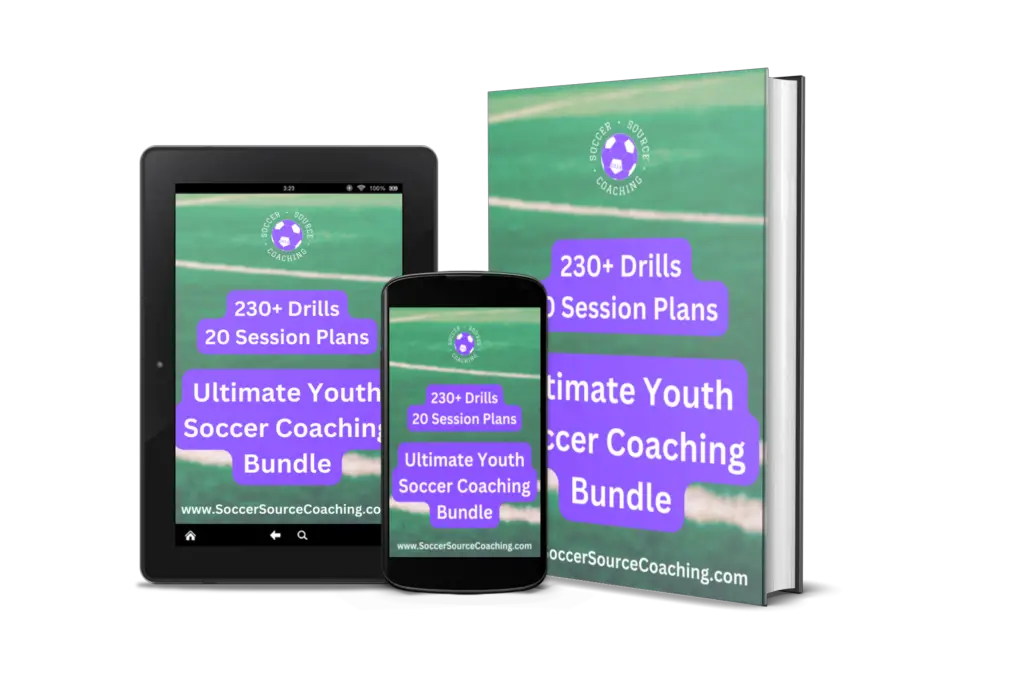
Take the stress out of coaching youth soccer with 250+ pre-made soccer sessions and drills, just turn up and coach!
Here’s the breakdown of what you’ll find inside:
- 35 Defending Drills
- 35 Dribbling and 1v1 Drills
- 21 SAQ Drills
- 47 Passing, Control, and Possession drills
- 31 Goalkeeper drills
- 36 Shooting and Finishing drills
- 30 Soccer Games U4 – U8
- 20 Pre-made soccer sessions (90 minutes in length each)
